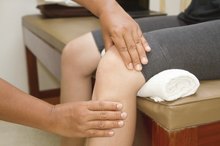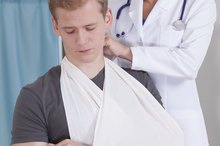Recovery & Rehabilitation Time for Shoulder Surgery to Remove Bone Spur
Bone spurs can develop in your shoulder joint due to aging or after an injury. These spurs can cause significant pain and limit movement by damaging tendons that move your shoulder. If this damage is severe or your pain cannot be relieved with conservative treatment, you may need surgery. Shoulder decompression surgery -- a procedure performed to remove bone spurs -- can significantly improve your shoulder mobility and alleviate pain. Recovery and rehabilitation time after shoulder decompression surgery is typically 3 to 6 months and occurs in phases 2.
If you are experiencing serious medical symptoms, seek emergency treatment immediately.
Immediately After Surgery
Immediately after surgery, you will likely have a large bandage covering your shoulder, with your arm resting in a sling to help support the weight of your arm for a few days. You may be instructed to apply ice to your shoulder, typically for 20 minutes for the first 24 to 48 hours after surgery. This helps decrease pain and swelling after surgery. Sleeping may be difficult, and you may be more comfortable sleeping in a recliner for the first few weeks. Keep your dressing dry, and do not remove the sling or dressing until directed by your doctor or physical therapist. You may start physical therapy within a few days of surgery, and your doctor will typically see you within 7 to 10 days to remove your stitches.
- Immediately after surgery, you will likely have a large bandage covering your shoulder, with your arm resting in a sling to help support the weight of your arm for a few days.
- You may be instructed to apply ice to your shoulder, typically for 20 minutes for the first 24 to 48 hours after surgery.
Phase 1
How Long Is Rehab After a Bicep Surgery?
Learn More
Phase 1 of recovery encompasses the first 2 weeks after surgery. This phase focuses on decreasing pain and inflammation while slowly beginning to regain movement in your shoulder. Specific exercises should only be performed as directed by your physical therapist or doctor. During this phase, however, you will likely perform pendulums -- dangling your arm and using your body to swing it in multiple directions. Exercises using a pulley or dowel, wherein you use your opposite arm to help your shoulder move, are also common during this phase. These exercises are initiated early to help prevent stiffness in your shoulder joint.
- Phase 1 of recovery encompasses the first 2 weeks after surgery.
- Exercises using a pulley or dowel, wherein you use your opposite arm to help your shoulder move, are also common during this phase.
Phase 2
Phase 2 typically begins 3 weeks after surgery when you have regained full movement of your shoulder, with or without assistance. This phase typically lasts through the 6th week after surgery. The focus is on strengthening your shoulder muscles and regaining your ability to use your shoulder for daily activities. Overhead reaching and heavy lifting are generally avoided at this phase, as these movements increase pressure in your shoulder joint. Once you are able to lift your arm on your own, you may start exercising with dumbbells or resistance bands.
- Phase 2 typically begins 3 weeks after surgery when you have regained full movement of your shoulder, with or without assistance.
- Overhead reaching and heavy lifting are generally avoided at this phase, as these movements increase pressure in your shoulder joint.
Phase 3
How Long Does it Take to Rehab From Meniscus Surgery?
Learn More
Phase 3 often begins 6 weeks after surgery and continues until you have regained full function of your shoulder. Strengthening exercises are usually continued and advanced. In this phase, you will also work on overhead activities and heavy lifting. If you're involved in sports, your rehabilitation program during this final phase will include exercises specific to your preferred activities.
- Phase 3 often begins 6 weeks after surgery and continues until you have regained full function of your shoulder.
- If you're involved in sports, your rehabilitation program during this final phase will include exercises specific to your preferred activities.
Related Articles
References
- The Open Orthopaedics Journal: The Painful Shoulder -- Shoulder Impingement Syndrome
- International Journal of Shoulder Surgery: Mid-Term Results of Arthroscopic Subacromial Decompression in Patients With or Without Partial Thickness Rotator Cuff Tears
- Sgroi TA, Cilenti M. Rotator cuff repair: post-operative rehabilitation concepts. Curr Rev Musculoskelet Med. 2018;11(1):86–91. doi:10.1007/s12178-018-9462-7
- American Academy of Orthopaedic Surgeons. Shoulder Surgery Exercise Guide. Updated February 2017.
- Fleming JA, Seitz AL, Ebaugh DD. Exercise protocol for the treatment of rotator cuff impingement syndrome. J Athl Train. 2010;45(5):483–485. doi:10.4085/1062-6050-45.5.483
- Hazar Z, Baltacı G. Effects of ’’Throwers Ten’’ Exercise Program on Pain and Function in Shoulder Impingement Syndrome: A Pilot Study. Orthop J Sports Med. 2014;2(3 Suppl):2325967114S00153. doi:10.1177/2325967114S00153
- Davies G, Riemann BL, Manske R. CURRENT CONCEPTS OF PLYOMETRIC EXERCISE. Int J Sports Phys Ther. 2015;10(6):760–786.
Writer Bio
Aubrey Bailey has been writing health-related articles since 2009. Her articles have appeared in ADVANCE for Physical Therapy & Rehab Medicine. She holds a Bachelor of Science in physical therapy and Bachelor of Arts in psychology from the University at Buffalo, as well as a post-professional Doctor of Physical Therapy from Utica College. Dr. Bailey is also a certified hand therapist.








